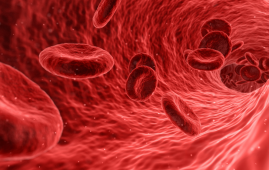

Tulane University researchers have discovered a previously undiscovered molecular route that could help to stop lung cancer in its tracks.
Lung cancer is the most frequent type of cancer and the main cause of cancer-related deaths worldwide. According to senior study author Dr. Hua Lu, the Reynolds and Ryan Families Chair in Translational Cancer at Tulane University School of Medicine, the research, published in Proceedings of the National Academy of Sciences, could lead to the development of a new anti-cancer drug and more personalized lung cancer treatment.
The researchers discovered that RBM10, a known tumor suppressor protein, can decrease lung cancer growth by reducing the action of c-Myc, a protein that, when overexpressed, causes cancer cell growth and proliferation. RBM10 collaborates with two ribosomal proteins (RPL5 and RPL11) to destabilize c-Myc and slow the progression of lung cancer, according to the findings.
These findings are the first to show that the proteins have an anti-cancer connection.
“We found that RBM10 can directly target c-Myc for degradation and reduce its cancer-causing effects by binding with RPL5 and RPL11,” he said. “We know a lot about cancer, but the molecules involved remain a mystery.” We are gradually obtaining a better grasp.”
Imagine two factories in a cell, each manufacturing parts for assembly into new protein machineries; c-Myc is a regular part of this protein production process—and cellular growth in general—and humans cannot live without it.
This manufacturing is occasionally disturbed, and firms begin creating defective parts. When cancer forms, it uses c-Myc to keep producing, allowing these “spare parts” to aggregate and create tumors. RBM10, in collaboration with RPL5 and RPL11, can destabilize c-Myc and inhibit tumor growth.
Importantly, the study demonstrated that a mutant form of RBM10 prevalent in lung tumors loses its ability to regulate c-Myc, fails to attach to the ribosomal proteins RPL5 and RPL11, and eventually promotes tumor growth rather than reducing it.
“RBM10 is an important protein that can suppress cancer cells, but when a cancer wants to develop, it will mutate RBM10 and block that function,” he said.
Lu intends to learn more about how the RBM10 mutant works in order to design an anti-cancer medicine that targets it.
“Hopefully we can design a molecule to specifically target the mutant, since that’s a special structure not existing in the normal tissue,” he said. “If we can convert this mutant, we can hopefully make it suppress c-Myc’s cancer-causing activity.”
more recommended stories
 Fat-Regulating Enzyme Offers New Target for Obesity
Fat-Regulating Enzyme Offers New Target for ObesityKey Highlights (Quick Summary) Researchers identified.
 Spatial Computing Explains How Brain Organizes Cognition
Spatial Computing Explains How Brain Organizes CognitionKey Takeaways (Quick Summary) MIT researchers.
 Gestational Diabetes Risk Identified by Blood Metabolites
Gestational Diabetes Risk Identified by Blood MetabolitesKey Takeaways (Quick Summary for Clinicians).
 Phage Therapy Study Reveals RNA-Based Infection Control
Phage Therapy Study Reveals RNA-Based Infection ControlKey Takeaways (Quick Summary) Researchers uncovered.
 Pelvic Floor Disorders: Treatable Yet Often Ignored
Pelvic Floor Disorders: Treatable Yet Often IgnoredKey Takeaways (Quick Summary) Pelvic floor.
 Urine-Based microRNA Aging Clock Predicts Biological Age
Urine-Based microRNA Aging Clock Predicts Biological AgeKey Takeaways (Quick Summary) Researchers developed.
 Circadian Control of Neutrophils in Myocardial Infarction
Circadian Control of Neutrophils in Myocardial InfarctionKey Takeaways for HCPs Neutrophil activity.
 E-Cigarette Use and Heart Attack Risk in Former Smokers
E-Cigarette Use and Heart Attack Risk in Former SmokersKey Takeaways for Clinicians and Nurses.
 36-Week Pre-eclampsia Screening May Reduce Term Risk
36-Week Pre-eclampsia Screening May Reduce Term RiskA New Preventive Strategy for Term.
 Cardiovascular Risk and Sudden Cardiac Death in Diabetes
Cardiovascular Risk and Sudden Cardiac Death in DiabetesRising Sudden Cardiac Death (SCD) Risk.

Leave a Comment